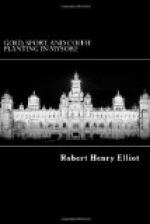CHAPTER XII.
MANURE.
The question of shade is, as we have seen, a highly complicated one, and is also, as we shall see, a cause of complication in the subject we are now about to consider; for, were no shade required, the subject of manuring the land for coffee would, comparatively speaking, be a simple one. And it is very important to call attention to this point, because hitherto planters have not in any way allowed shade to disturb their manurial practices, but have applied their manures equally to land under the direct shade of the trees, and to the open spaces between them, which are only under the influence of lateral shade, or, in other words, have manured their land as if there were no shade trees on it whatever. A little consideration, however, will show that the kinds and qualities of the manures applied should be quite different under the shade of trees, from what they ought to be in the open spaces between them. For, close around the stems of the shade trees we have a large leaf deposit, which manures the soil and maintains its physical condition, and, at the same time, comparatively speaking, small crops of coffee, while in the open spaces between the shade trees we have a small amount of leaf deposit, and much heavier crops of coffee. If, then, we further take into consideration the fact that the soil between the shade trees is liable to be deteriorated by a greater exposure to wash and to baking from the sun after the soil has been thoroughly soaked, it is evident that manuring should be largely varied both in quality and quantity, if we are at once to manure efficiently and economically. And I desire the more particularly to call attention to this matter, because no planter, as far as I am aware, has at all studied the subject. And it is principally of very great importance because what we call bulk manures, i.e., farmyard manures, pulp, composts, and top soil, are difficult to procure in large quantities, and cost much to apply, as they have to be carried on coolies’ heads, and often for considerable distances, down the rows of coffee trees. The more, then, we can limit our applications of bulk manure to such lands as urgently require them, the better shall we be able to devote a full supply to the soil which most requires such manures. Now if we apply our bulk manures to the land directly under the shade trees, we shall certainly be injudiciously using our mammal resources, because the leaf deposit under the shade trees supplies exactly that kind of padding which gives its chief value to bulk manures, and, if these opinions are sound, it therefore follows that we should, as a rule, apply all our bulk manures to the spaces between the shade trees, and only apply them to the land under the shade trees, when, from the soil being of a clayey character, an occasional application of bulk manure may be required to improve the texture of the soil, or, in other words, make it more easily workable. And it also follows that we should only apply bones, lime, and ashes, fish and oil-cake to the coffee under the direct influence of the shade trees.




